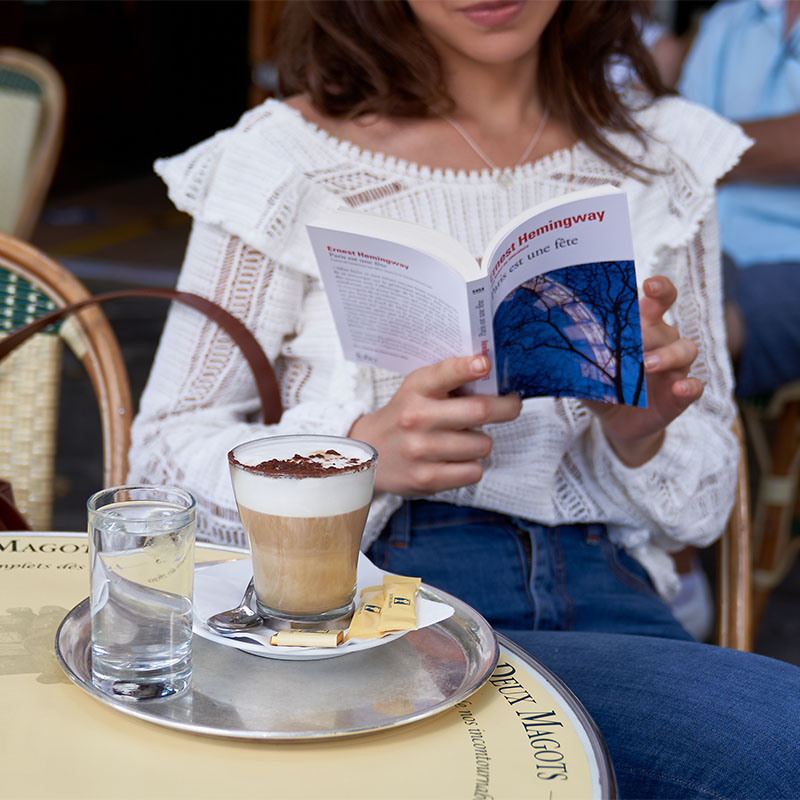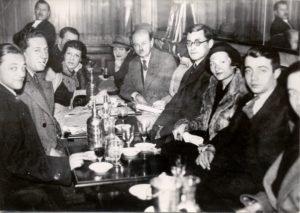The best literary cafés in Paris
Are you a lover of words and cosy atmospheres? Do you appreciate places with an authentic history and want to sit at tables that have seen the greatest writers pass through? Here is a selection of literary cafés in Paris that will charm you.
Les Deux Magots: the most inspiring literary café in Paris

Located in the heart of the 6th arrondissement, Les Deux Magots is more than a café, it is an authentic institution. Founded in 1812 at 23 rue de Buci, it was transferred to Place St-Germain-des-Prés in 1873 to expand. The two statues that adorn the room today still bear witness to this era.
In fact, it is these two statues that gave its name to the establishment, the “magots” in question being the Chinese figurines that first gave its name to a novelty store.
Then, in 1885, the store gave way to a liquor store that kept the same name. Verlaine, Rimbaud and Mallarmé, among others, got used to meet there.
This café began to play an important role in Parisian cultural life before affirming its literary vocation in 1933 with the creation of the Prix des Deux Magots.
Since then, Les Deux Magots has welcomed many illustrious artists, including Elsa Triolet, Louis Aragon, André Gide, Jean Giraudoux, Pablo Picasso, Fernand Léger, Jacques Prévert, Ernest Hemingway…
The place then became the landmark of the surrealists under the aegis of André Breton, then of the existentialists around Sartre and Beauvoir. One can imagine the heated debates, the friendships made, the projects sketched out in the den of the Deux Magots.
Today, just as popular, one of the oldest cafés in Paris attracts personalities from the worlds of art and literature, fashion and politics.
This unique literary café regularly organizes jazz concerts, literary meetings and exhibitions. He hosts prestigious literary award ceremoniesincluding the famous Prix des Deux Magots, created in 1933, but also the Prix Apollinaire and the Prix Pelléas.
You will be left with a major challenge when you enter this place steeped in culture and history: choosing between the large room that has hosted so many renowned artists and the terrace facing the oldest church in Paris, where the atmosphere of the Saint-Germain-des-Prés district is fully felt.

The Procope
Another literary café in Paris, the Procope, opened its doors in 1686. It was then the place to go in Paris to drink a coffee, while consulting the press of the time or a literary work. The literary personalities of the time, among which Regnard or Racine, frequented this place. A century later, the Procope became the landmark of the leading authors of the Enlightenment. This Parisian literary café has also created its own prize like the Café des Deux Magots: the Procope des lumières prize and the Prix de Cuisine bourgeoise.
The Café de la Paix
Literary café of Paris Rive Droite, located in the Opera district, at the corner of the Boulevard des Italiens and the Place de l’Opéra, it is one of the last born of the great literary cafés of Paris. Founded in 1862, it has welcomed famous writers such as Oscar Wilde, Tristan Bernard or André Gide. At the Café de la Paix, you can enjoy foie gras, tartar, sole and onion gratin, not to mention oysters, shellfish and crustaceans from the Banc de l’Écailler, in a stylish setting.
Le Café de Flore
This Parisian literary café is located in the heart of the Saint Germain-des-Prés district. It was created a few years after the Café de le Paix in 1887, a few steps from the Café Les Deux Magots. Mourras will frequent it at the end of the 19th century and will give birth to his masterpiece “Au signe de Flore”, then Guillaume Apollinaire will establish his quarters there. The director Marcel Carné, a faithful visitor to this literary café, would meet there with friends such as Serge Reggiani.
The director Jean-Louis Barrault settled there regularly with his actors. You may also feel, in the Café de Flore, the presence of Eugène Ionesco, of Louis Malle who decided to shoot one of his major works there. In the wake of other literary cafés, the Café de Flore has also created its own literary prize: the Prix de Flore, awarded each year in the fall.
La Closerie des Lilas
A literary café founded in the second half of the 19th century, the Closerie des Lilas was, in the early 1860s, the meeting place of the “intransigents”, a group of painters coming out of Charles Gleyre’s studio at the École des Beaux-Arts in Paris, and including Bazille, Renoir, Monet and Sisley, soon joined by Pissarro, who would become the Impressionists. We also meet Émile Zola, Paul Cézanne, Théophile Gautier, Charles Baudelaire and the brothers Jules and Edmond de Goncourt. Immediately adjacent to the Bullier Ball, a post house becomes the gathering place for people who come to the ball. In 1883, this relay agreed with the heirs of François Bullier and the establishment was renamed La Closerie des Lilas, becoming a meeting place for artists from all horizons.
Today, the Closerie des Lilas, which is mostly known for its restaurant activity, has also created its literary prize in 2007, awarded exclusively to women, under the impulse of its new owners, who also own the Café de Flore.